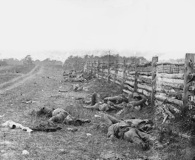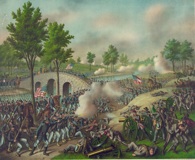Virtual Tour Antietam: The Civil War’s Bloodiest Day
The Battle
 The Battle of Antietam, fought along a north-south line running through Sharpsburg and chiefly to its north and east, took place on September 17, as Lee’s 52,000 men and McClellan’s 75,000 soldiers grappled in a series of encounters along Antietam Creek. The total bloodletting for both sides numbered some 4,808 men killed and another 21,326 wounded or missing. It was a horrific loss to the nation. And it began as Union Major General Joseph Hooker’s I Army Corps struck southward early in the morning, toward Jackson’s Confederate corps. Hooker, who was himself wounded in the action, surged through the North Woods (see battle map) and into the cornfield of David R. Miller’s farm, one of the scenes of heaviest carnage. “Every stalk of corn in the northern and greater part of the field was cut as closely as could have been done with a knife,” Hooker wrote, “and the slain lay in rows precisely as they had stood in their ranks a few moments before. It was never my fortune to witness a more bloody, dismal battlefield.”
The Battle of Antietam, fought along a north-south line running through Sharpsburg and chiefly to its north and east, took place on September 17, as Lee’s 52,000 men and McClellan’s 75,000 soldiers grappled in a series of encounters along Antietam Creek. The total bloodletting for both sides numbered some 4,808 men killed and another 21,326 wounded or missing. It was a horrific loss to the nation. And it began as Union Major General Joseph Hooker’s I Army Corps struck southward early in the morning, toward Jackson’s Confederate corps. Hooker, who was himself wounded in the action, surged through the North Woods (see battle map) and into the cornfield of David R. Miller’s farm, one of the scenes of heaviest carnage. “Every stalk of corn in the northern and greater part of the field was cut as closely as could have been done with a knife,” Hooker wrote, “and the slain lay in rows precisely as they had stood in their ranks a few moments before. It was never my fortune to witness a more bloody, dismal battlefield.”
The fighting throughout the morning rippled southward, to the West Woods, where Jackson was stubbornly defending an area surrounding the Dunkard Church, a little white landmark near the center of the field. Lee directed the battle from a headquarters established in Sharpsburg, whereas McClellan watched from afar at the Philip Pry House to the northeast. Intense fighting raged around the Samuel Mumma Farmhouse and its accompanying cemetery — the house was set ablaze by retreating Confederates. Waves of Union attacks pushed southward toward a sunken farm road that would acquire the name Bloody Lane before the day was out. Colonel John B. Gordon, helping to direct the Confederate regiments huddled in Bloody Lane, was wounded five times this day. “I fell forward and lay unconscious with my face in my cap,” recalled Gordon, “and it would seem that I might have been smothered by the blood running into my cap from this last wound but for the act of some Yankee, who, as if to save my life, had at a previous hour during the battle, shot a hole through the cap, which let the blood out.”
{default}The fearsome nature of the battle rocked even the combat veterans in the ranks. “The mental strain was so great that I saw at that moment the singular effect mentioned, I think, in the life of Goethe on a similar occasion — the whole landscape for an instant turned slightly red,” wrote David Thompson of the 9th New York Infantry Regiment. Others felt more secure amidst the chaos. “How natural it is for a man to suppose that if a gun is discharged, he or some one is sure to be hit,” wrote Frank Holsinger, a Union soldier. “He soon finds, however, that the only damage done, in ninety-nine cases out of a hundred, the only thing killed is the powder! . . . I have frequently heard the remark that it took a man’s weight in lead to kill him.” Other soldiers, such as a young Rob Lee, the commanding general’s son, simply asked for clarification. “General Lee was dismounted,” wrote Rob Lee, “with some of his staff around him, a courier holding his horse. Captain Poague, commanding our battery, the Rockbridge Artillery, saluted, reported our condition and asked for instructions. The General, listening patiently, looked at us — his eyes passing over me without any sign of recognition — and then ordered Captain Poague to take the most serviceable horses and men . . . As Poague turned to go, I went up to speak to my father. When he found out who I was he congratulated me on being well and unhurt. I then said: ‘General, you are going to send us in again?’ ‘Yes, my son,’ he replied with a smile. ‘You must all do what you can to help drive these people back.’”
 As the afternoon aged, the battle flared farther to the south, where Union Major General Ambrose E. Burnside was supposed to bring his IX Army Corps across Antietam Creek and strike the Confederates from the east. Burnside delayed for hours and then finally crossed the Lower Bridge (later called Burnside Bridge) in a thin column that led to the slaughter of many of his troops. Burnside’s movement and pressure from the area of Bloody Lane pushed the Confederates back toward Sharpsburg, but the “Light Division” of A. P. Hill arrived from Harpers Ferry in the nick of time, mounting a thunderous counterattack that ended the day’s action. No side had gained a decisive victory. McClellan had not even employed his V Army Corps, and Lee had failed in his strategic goals, retreating south of the Potomac on September 19.
As the afternoon aged, the battle flared farther to the south, where Union Major General Ambrose E. Burnside was supposed to bring his IX Army Corps across Antietam Creek and strike the Confederates from the east. Burnside delayed for hours and then finally crossed the Lower Bridge (later called Burnside Bridge) in a thin column that led to the slaughter of many of his troops. Burnside’s movement and pressure from the area of Bloody Lane pushed the Confederates back toward Sharpsburg, but the “Light Division” of A. P. Hill arrived from Harpers Ferry in the nick of time, mounting a thunderous counterattack that ended the day’s action. No side had gained a decisive victory. McClellan had not even employed his V Army Corps, and Lee had failed in his strategic goals, retreating south of the Potomac on September 19.
There was one important strategic goal accomplished for the Lincoln administration, however. The “victory” at Antietam (measurable at least by Lee’s retreat) allowed the President to issue a preliminary proclamation to emancipate slaves in areas in rebellion against the United States. It would be the first move in transforming the war into a struggle of an order more complex than simply preserving the Union. Lincoln’s preliminary proclamation, issued on September 22, concluded, “On the first day of January in the year of our Lord, one thousand eight hundred and sixty-three, all persons held as slaves within any state, or designated part of a state, the people whereof shall then be in rebellion against the United States shall be then, thenceforward, and forever free.”
The proclamation would be issued legally effective on January 1, 1863. For the moment, it seemed to change nothing in the field, particularly for the soldiers, who struggled with a war of increased philosophical complexity that they now understood even less. But in the end, the strategic significance of Antietam and of the Proclamation was enormous. It began the long process of equality that would drag on for decades to come before finally taking hold in the consciousness of the United States.
[continued on next page]


0 Comments
Trackbacks/Pingbacks